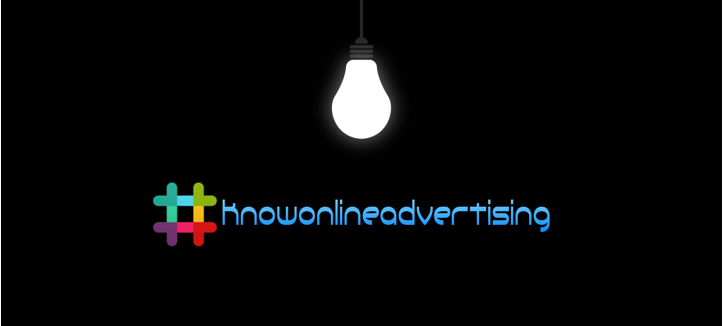
Hashtag provides a way to categorize the content on social media. Users can find the relevant information by searching with the keyword which the hashtag contains. You can start a new conversation and have others join in or you can look for any existing discussion and become a part of it. One can get regular updates related to any ongoing global event. It enhances the visibility of your post which benefits the marketers in the
business . Social media is loaded withcontent and hashtag is an effective means to locate what you exactly need.
History of Hashtag:
Prior to 2007, # was referred to as a pound symbol. But 23rd August changed the fate of this symbol. The idea of using a
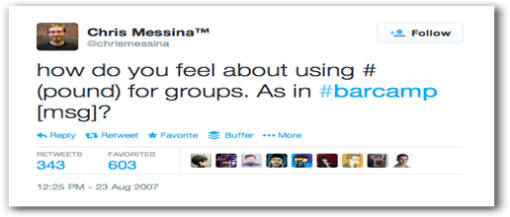
Hashtag on social media:
A hashtag is a word or a phrase preceded by the # sign. They are used on social media posts. It is a keyword or label which connects the social post to a specific topic or an ongoing conversation. Hashtag lets the users categorize their social content and also enables them to search for posts and topics they are interested in. You can locate what you exactly need on social media searching via hashtag. One can get regular updates related to any ongoing global event. It enhances the visibility of the posts which benefits the brands as well as personal social accounts. Brands can initiate a conversation and connect with their target audience.
The effectiveness of any digital marketing campaign is measured primarily in terms of the number of online users it is able to reach out to who ends up engaging with the campaign. Owing to their extremely high user engagement rate, social media platforms like Facebook, Twitter, Instagram, Pinterest have become the most preferred avenue for endorsing a product.
Twitter: It is where the journey of hashtag began and soon grabbed the attention of users worldwide. Posts with a hashtag on twitter increase user engagement and get more views. Brands can reach out to target audiences with specific messages which provide improved results. Users can search for trending conversations with hashtags and can join the same.
Instagram: Post 2011, Instagram officially allowed linking hashtag on posts. It works a bit differently when it comes to the number of
Facebook: Use of hashtag is least effective on Facebook as the profiles are usually private and posts don’t reach beyond family and friends. Hashtag works best on Facebook if the profiles are public so that users can search posts with hashtags and can connect to it. Just one or two hashtags on each post should be enough and one must avoid using excessive hashtags.
Points to remember while using the hashtag:
- They always start with # sign.
- Do not use spaces between the words. No punctuation or special character is allowed.
- Always use short hashtag. Avoid using long string of words.
- Limit the use of the hashtag to not more than one to two in each post.
- Only on Instagram, one should focus on using more number of hashtags.
- Try using a specific keyword as hashtag which is more likely to be searched by the users. The hashtag should clearly indicate what it’s referring to.
- Avoid using long strings as a hashtag and stick to short words. Long strings are least expected to be searched by the users.
- Knowledge of the target audience is essential before selecting the hashtag. You must know the interest of your users and what keywords they are most likely to search for.
- Always link hashtag with a meaning – Hashtag’s true power comes when it becomes fun for a larger part of the community and engages in the conversation.
- Use a hashtag that people wouldn’t be afraid to write down – Imagine yourself as a personal photo to Instagram – what hashtags do you use? Exactly. Simple, funny, easy to remember, sometimes very sophisticated. So don’t be overwhelmed with the company’s communication, be earthy.
- Do not use more than two or a maximum of three hashtags in a post. It’s always better to limit the number hashtags.
- Encourage engagement – Hashtag is basically used to draw attention, make a conversation, and perfect if the action is still successful.
Advantages of using hashtag:
- Others can find your post: Hashtag lets a brand be found by their target audience. For this to happen, brands must focus on using a relevant hashtag which their customers or prospects are most likely to search for. As the users search for these hashtags, they can connect with the brand and view the brand’s content.
- Adds context to your post: All social media platforms are flooded with millions of posts. For you to stand out from the rest you need to add a label to it which contextualize it and lets others know what you are talking about. Hashtag segments the post and relates it to a specific topic, brand, event or conversation,
- Enhances reach and grows the brand: Users across the globe can search for the relevant hashtag and find the brand they are interested in. Brands are able to expand the audience base and attract potential customers. Using hashtag brands can join an ongoing conversation to express their views and they can also start a new conversation. The hashtag also allows them to promote a specific product, event, or upcoming sale.
- People with a similar common interest can connect: Like-minded people with similar interest areas can connect and communicate with each other. Through hashtags, they are able to view each other’s posts and messages.
- Increases engagement on social media: Social posts with hashtags tend to bring higher engagement and click-through rates. Hashtag categorizes the content for the users who are able to connect with a specific topic as per their liking.
- It enhances the reach of posts as relevant and interested users to able to locate and connect with the brand.
- Users can join an ongoing conversation and also have the option of building a community for people to discuss common topics.
- Brands can use customized hashtags like the name of the brand which helps in creating awareness about the brand.
- One can search for trending topics and try using them on your posts which certainly attracts a larger group of audience.
Tools for tracking hashtag:
The use of hashtags has grown immensely on social media platforms. Be it on individual accounts or brands, all are using it for various purposes and achieve their goals. Most of the brands use customized hashtags to link their content to specific topics and group them accordingly. But, the mere usage of a hashtag on social posts doesn’t guarantee views, clicks, and engagement. It requires rigorous planning, research, and knowledge of your user base to come up with relevant hashtags. Also, you require a way to track the performance of these hashtags and monitor if they actually getting traffic.
Below are some tools that can be utilized for tracking the hashtags used on the campaign.
- RiteTag: It is one of the most widely used tools for monitoring the performance of hashtags. It is part of Ritekit. It is a great tool when it comes to finding the trending hashtags. It provides a wide range of data to the users which includes which hashtags are most likely to bring higher engagement and which ones are losing popularity. Users have access to weekly, daily, and real-time tracking data.
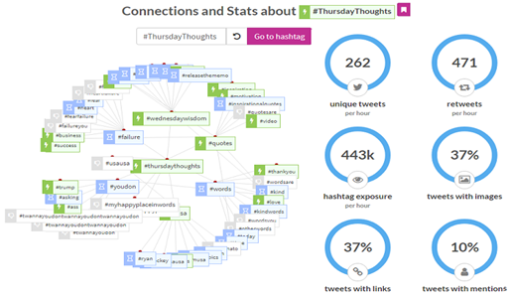
- Brand24: Another effective tool for hashtag tracking as well as hashtag analytics. It can monitor hashtags across Instagram and Twitter. In fact, it not only monitors but also analyses the performance of hashtags. It provides data across important metrics like no. of hashtag mentions, a number of interactions, and engagement produced via hashtag including comments, likes and share.
- Hashtagify: Another hashtag tracking tool which is available in both free as well paid version and provides users with amazing features to explore. It provides information regarding the popularity of the hashtag, similar hashtag being used, no. of times hashtag featured, and engagements. Users can view the usage patterns which reflect the time of the day when the hashtag was used the most and how did it perform. One can also look for related hashtags.
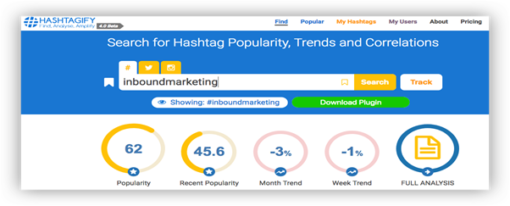
- Twubs: It’s a very different tool as compared to the ones mentioned above. One can initiate a conversation around a hashtag and can join a chat room to interact with others. Twubs has a hashtag directory which can be looked up to find specific hashtag feeds and join the chat room. You can also register your own hashtag, create a chat room, and embed the feed into your website.
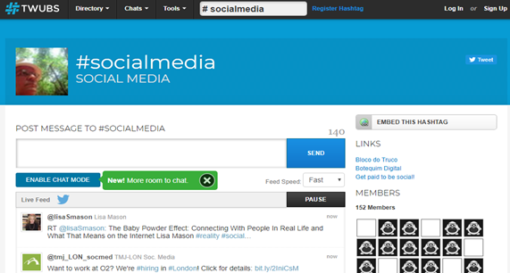
- KeyHole: This tool enables real-time hashtag tracking on Instagram and Twitter. It provides data on the number of posts with hashtags, who used the hashtag, impression, and reach. The tool also suggests on how to optimize hashtag to achieve higher engagement. While planning a hashtag strategy, KeyHole provides a list of related hashtags and their performance data.
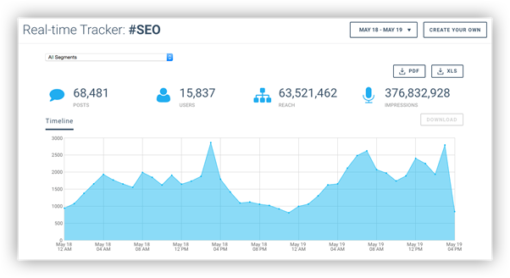
20 popular hashtag across the world:
- #love
- #instagood
- #photooftheday
- #fashion
- #beautiful
- #happy
- #cute
- #tbt
- #like4like
- #followme
- #picoftheday
- #follow
- #me
- #selfie
- #summer
- #art
- #instadaily
- #friends
- #repost
- #nature
Very well researched content, this website is now my readyreckoner and my most important bookmark 🙂
Thanks Manoj. Good to hear that.
Thats an insight